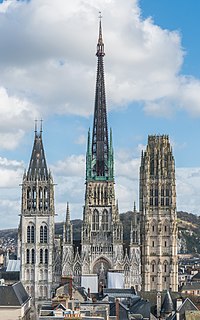Cathédrale Notre-Dame de Rouen
| Rouen Cathedral | |
|---|---|
| Cathedral of Notre Dame | |
| French: Cathédrale primatiale Notre-Dame de l'Assomption de Rouen | |
 |
|
| Location | 3 rue Saint-Romain 76000 Rouen, Normandy |
| Country | France |
| Denomination | Roman Catholic |
| Website |
rouen www |
| History | |
| Dedication | Our Lady of Rouen |
| Consecrated | 1 October 1063 in the presence of William the Conqueror |
| Relics held | Saint Romain |
| Architecture | |
| Status | Cathedral |
| Functional status | Active |
| Heritage designation | Classée Monument Historique |
| Designated | 1862 |
| Style | Gothic |
| Groundbreaking | 1030 |
| Completed | 1880 |
| Specifications | |
| Number of towers | 2 |
| Number of spires | 2 |
| Bells | 70 by Paccard (64 in the Saint-Romain Tower and 6 in the Butter Tower). It is the heaviest peal of bells in France (the overall weight of the cathedral's 64-bell carillon reckons at 36 tons). |
| Administration | |
| Archdiocese | Rouen |
| Clergy | |
| Archbishop | Dominique Lebrun |
| Pastor(s) | Fr. Christophe Potel |
| Laity | |
| Organist(s) | Lionel Coulon |
| Building details | |
| Record height | |
| Tallest in the world from 1876 to 1880 | |
| Preceded by | Sankt-Nikolai-Kirche |
| Surpassed by | Cologne Cathedral |
| General information | |
| Coordinates | 49°26′25″N 1°05′42″E / 49.4402°N 1.0950°ECoordinates: 49°26′25″N 1°05′42″E / 49.4402°N 1.0950°E |
| Height | |
| Antenna spire | 151 m (495 ft) |
| References | |
Rouen Cathedral (French: Cathédrale primatiale Notre-Dame de l'Assomption de Rouen) is a Roman Catholic Gothic cathedral in Rouen, Normandy, France. It is the see of the Archbishop of Rouen, Primate of Normandy.
A church was already present at the location in the late 4th century, and eventually a cathedral was established in Rouen as in Poitiers. It was enlarged by St. Ouen in 650, and visited by Charlemagne in 769.
All the buildings perished during a Viking raid in the 9th century. The Viking leader, Rollo, founder of the Duchy of Normandy, was baptised here in 915 and buried in 932. His grandson, Richard I, further enlarged it in 950. St. Romain's tower was built in 1035. The buildings of Archbishop Robert II were consecrated in 1065. The cathedral was struck by lightning in 1110.
Construction on the current building began in the 12th century in Early Gothic style for Saint Romain's tower, front side porches and part of the nave. The cathedral was burnt in 1200. Others were built in High Gothic style for the mainworks: nave, transept, choir and first floor of the lantern tower in the 13th century; side chapels, lady chapel and side doorways in the 14th century. Some windows are still decorated with stained glass of the 13th century, famous because of a special cobalt blue colour, known as "the blue from Chartres". The north transept end commenced in 1280.
...
Wikipedia
